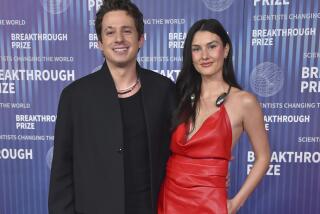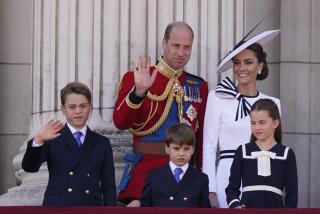‘Return of Happiness’ as Charles Weds Camilla
- Share via
WINDSOR, Britain — Nearly 35 years after their romance began, Prince Charles, the heir to the British throne, took Camilla Parker Bowles as his wife Saturday, pledging to be faithful to her and to forsake all others as long as they both shall live.
The wedding, an important act of tidying up for the oft-troubled monarchy, represented the formalizing of a love affair that many blamed for the breakup of Charles’ marriage to the popular, beautiful Princess Diana.
Now Her Royal Highness, the Duchess of Cornwall, the 57-year-old Camilla becomes the second-ranked woman in the royal family after the queen.
Wearing an ivory dress and a large hat worthy of a monarch, she reached out to the public with a hesitant up-and-down wave after the private civil marriage ceremony in this castle town’s Guildhall.
On the bride’s wedding finger were an enormous diamond and platinum engagement ring and a band fashioned of Welsh gold.
The 56-year-old Charles, dressed in a cutaway jacket, was beaming, and mouthed the words, “Thank you very much,” to the cheering onlookers. His sons, Prince William and Prince Harry, and a raft of lesser royals followed behind.
Spectators, including many who had been standing for six hours or more to secure the best vantage points across from the hall, had only a few moments to appraise the newly married pair before they set off in their wedding limousine, a black-over-oxblood 1962 Rolls Royce Phantom V lent to them by the queen.
“Chaz and Millie, congratulations” said one cheeky sign. A banner by two sisters from Lancashire read: “Let He Who Is Without Sin Cast the First Stone.”
“We did it just to give support to Charles and Camilla,” said one of the sisters, Lenny Southwood. “Their love has stood the test of time, and they have survived the vilification and spite of the press, with great dignity.”
One twentysomething onlooker, Tricia Gardiner, was bundled in a warm coat against the chill air and wearing a rhinestone tiara.
“You can’t miss history. It’s not going to happen again, is it?” she said. To which her friend Michelle Farmer said, “That’s what we said last time.”
After the civil exchange of vows, witnessed by only a few dozen close family members and friends, Charles and Camilla emerged for a much more public and elaborate religious service of “prayer and dedication,” televised nationwide.
In the splendid surroundings of the 15th century St. George’s Chapel, and presided over by Rowan Williams, the archbishop of Canterbury, the two knelt and expressed remorse for their past acts.
In strong words they had chosen from a pre-Reformation church text, they acknowledged “manifold sins and wickedness,” and along with the 750 members of the assembled congregation said, “We do earnestly repent, and are heartily sorry for these our misdoings.”
Charles’ parents, Queen Elizabeth II and Prince Philip, accompanied their son at the service and gave their first public approval of the union. The palace said the queen had been absent from the civil ceremony to respect her son’s wishes that it be low-key, but royal watchers said she felt duty-bound, as supreme governor of the Church of England, to give precedence to the religious rites.
For the blessing ceremony, Camilla changed into a porcelain blue silk dress embroidered with gold thread, inspired by a piece of jewelry that had belonged to Camilla’s mother. Her striking headdress of gold-leafed feathers tipped with crystals was made by milliner Philip Treacy -- not quite a tiara, but regal nevertheless.
The couple walked unescorted out of the chapel, but were joined on the steps by the queen and Prince Philip, the first time they were photographed together as a family. Camilla could be seen joking with Prince Philip, while Charles touched his mother as they smiled warmly at each other.
At the service, guests included an eclectic mix of the couple’s friends and associates. Among them were Prime Minister Tony Blair and his wife, Cherie Booth, actors Kenneth Branagh and Joanna Lumley, comedian Joan Rivers, author John Mortimer and about a dozen kings, queens and princes from Europe and the Middle East. Camilla’s first husband, Andrew Parker Bowles, was also present.
Police estimated that up to 20,000 people had lined the streets of Windsor for the occasion, and among those who turned up, the mood was overwhelmingly supportive of the couple. But there were a scattering of boos when Charles and Camilla drove up outside the Guildhall, and a few people held up signs expressing loyalty to Princess Diana.
“He is crazy. He is marrying his mother. She is too old and needs a face-lift,” said Myrian Pineda, an English student from Colombia, who was waiting to see the couple. She chatted with a Costa Rican, Daniel Obanda, employed as a clown to drum up business for a local shop.
“I think Diana is here now. I don’t know why,” he said. “The people think so too, and that is why they are quiet in their hearts.”
But Anthony Urbanowski, a journalist with a radio travel show in Birmingham, said the couple had taken “a lot that they don’t deserve.” “It’s the British way of life, isn’t it? Pick somebody up to the top, and knock him down when he gets there,” said the 23-year-old, who had traveled to Windsor with two friends “to see history in the making.”
When Charles and Diana wed in 1981, more than 600,000 thronged the streets of London. In later years, Diana’s popularity came to exceed that of her often stiff and quirky husband, especially after she appeared to have been wronged and abandoned by him.
When their marriage finally ended in 1996, after Charles’ infidelity and Diana’s own affairs became quite widely known, Camilla was held to blame as the other woman.
Diana’s death in an automobile accident in Paris in 1997 only added to public disapproval of Charles and Camilla, and as a result the two were very slow to put their relationship in the public eye.
But the stately, tasteful wedding Saturday could set the stage for an eventual reassessment of Camilla, who, according to acquaintances, is a warm, upbeat person with a sense of humor, able to lift Charles out of his occasional emotional troughs.
The wedding ended on one particularly lighthearted note.
As they departed for Northolt air base to fly to their honeymoon in Scotland, they left in a royal Bentley on whose windshield had been written -- evidently in soap, and evidently by their children -- “PRINCE + DUCHESS,” and on a side window, “C+C.”
The hopeful mood was reflected in the flowers at the Guildhall ceremony, which included jasmine and cut stems of lily of the valley, symbolizing what palace officials said was “the return of happiness.”
Britain’s poet laureate, Andrew Motion, wrote a poem for the occasion that alluded to Charles’ earlier marriage and the presumed fulfillment that he will receive from his union with Camilla.
It concludes:
The heart which slips and sidles like a stream
Weighed down by winter-wreckage near its source --
But given time, and come the clearing rain,
Breaks loose to revel in its proper course.
More to Read
Sign up for Essential California
The most important California stories and recommendations in your inbox every morning.
You may occasionally receive promotional content from the Los Angeles Times.














